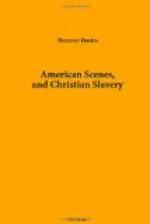While the congregation was assembling, a greyheaded, aristocratic-looking old negro came up into the gallery, walked along “as one having authority,” and placed himself in a front pew on the right-hand side of the pulpit. Two black women shortly followed, taking their seats in the same region. Others succeeded, till ultimately there were from forty to fifty of the sable race in that part of the gallery. Not one white was to be seen among the blacks, nor one black among the whites. There, then, was the “Negro Pew!” It was the first time even my West India eyes ever beheld a distinction of colour maintained in the house of God!
At eleven o’clock precisely, a man of tall but stooping figure and dark complexion, about forty years of age, muffled up in a cloak, took his stand at the bottom of the pulpit or platform stairs. It was Dr. S——. He appeared to beckon to some one in the congregation. A tall, lank old gentleman, with a black cravat, and shirt-collar turned over it a l’Americain, stepped forward, and, ascending the steps before the Doctor, occupied one of the two chairs with which the rostrum was furnished, the Doctor taking the other. I supposed him to be one of the elders, going to give out the hymns, or to assist in the devotional exercises. At this moment the organ—a fine-toned instrument—struck up, and the choir sang some piece—known, I presume, only to themselves, for no others joined in it. This prelude I have since found is universal in America. In all places of worship provided with an organ, a “voluntary” on that instrument is the first exercise. In the present instance the choir had no sooner ceased than the Doctor stood up, having his cloak still resting upon his shoulders, and stretched forth his right hand. At this signal all the people stood up, and he offered a short prayer. “Where is Abel, thy brother?” thought I, during this address to the Father of the spirits of all flesh. He then read the 23rd and 24th Psalms. “Where is Abel, thy brother?” was still ringing in my ears. The 33rd Psalm was then sung. “Where is Abel, thy brother?” was still heard (by me at least) louder than the swelling tones of the organ. The singing done, of which the choir still had an entire monopoly, the Doctor read the 14th chapter of Mark; and as he read the awful story of our Lord’s betrayal, I could not help thinking that the only difference between some of the Southern slave-dealers and Judas was, that had they been in his place, they would have made a “smarter” bargain. The reading, though free from affectation, was not by any means in the best style. The chapter finished, the tall elder (as I took him to be) prayed,—the congregation standing. The prayer was short and appropriate, and the language tolerably correct; but the tone and pronunciation were queer. I supposed them to indicate some provincialism with which I was not acquainted. Along with that peculiar nasal sound for which nearly all Americans are distinguished,




